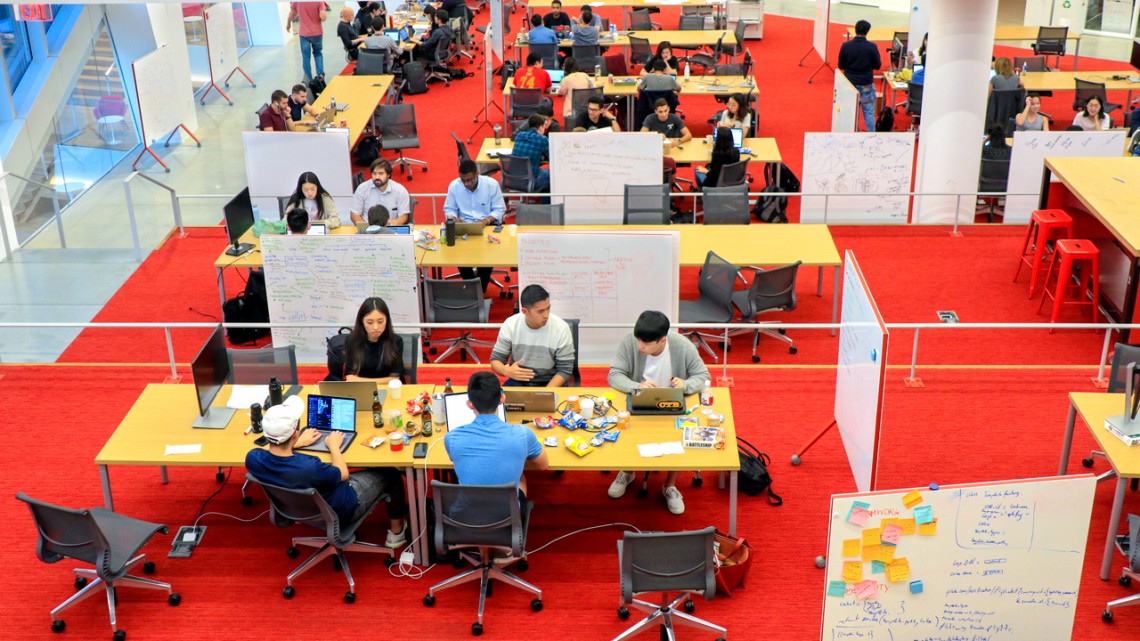
Master’s students in matter design computation take part in a Product Studio “sprint” session in the Tata Innovation Center at Cornell Tech.
AAP-Cornell Tech partnership crosses disciplinary boundaries
By Patti Witten
This semester, students in the College of Architecture, Art and Planning (AAP) may find themselves working with future colleagues and company co-founders, as they design and develop innovative products in a new interdisciplinary partnership at Cornell Tech.
“We are collaborators, working together rather than simply adjacent to one another,” said Cameron Nelson, a first-year student in the Master of Science in Matter Design Computation (M.S. MDC) program.
Nelson is participating in a pilot partnership that combines both M.S. MDC students and undergraduate architecture students at AAP NYC with Cornell Tech students in collaborative projects to develop digitally enabled solutions that address challenges posed by a diverse range of companies.
Launched Aug. 27, the partnership was advanced by Jenny Sabin, the Arthur L. and Isabel B. Wiesenberger Professor in Architecture and associate dean for design initiatives; J. Meejin Yoon, the Gale and Ira Drukier Dean of AAP; and Andrea Simitch, a Stephen H. Weiss Presidential Fellow and architecture department chair. It springs from the college’s priorities of creating interdisciplinary opportunities and pursuing cross-college initiatives in design.
The MDC program has grown by seven seats this semester; those students, including Nelson, are part of the new program in New York City. They join Cornell Tech master’s students in computer science, business, engineering, law, health tech and connective media in the Jacobs Technion-Cornell Institute.
Sabin has worked since 2011 to develop a graduate architecture curriculum that enhances collaboration within the college, the department and the university. Sabin credits Yoon, who joined the college Jan. 1, with crafting a strong presence for AAP within the unique model at Cornell Tech and for strengthening AAP’s alliance with Cornell Tech’s emphasis on entrepreneurial ventures and collaboration.
“Design is inherently interdisciplinary,” Yoon said. “At a moment when the challenges facing the built environment and society are multiscale, complex and dynamic, the collaborative initiatives between AAP and Cornell Tech will give our students opportunities to engage in pressing questions across technology, human-centered design and the built environment with an expanded perspective on the design challenges facing society today.”
Simitch sees this collaboration as a model for architecture as well as a radical extension of it.
“Architecture pedagogy is by default a collaborative practice based on interactive dialogues – dialogue with one’s own work from drawing to model, between faculty and students, and between peers and colleagues, as well as our discipline’s fundamental dialogue with our rapidly expanding contexts,” she said.
Sabin said that as designers, architecture students have unique skills to contribute to the interdisciplinary teams.
“Our undergraduate and graduate students bring an ability to synthesize a set of complex relationships, form a plan and follow through in a meaningful way. It’s not only about problem-solving, but problem-generating,” she said. “I’m excited to see what they do and how what we do well in educating our students strengthens their facility for expanding collaboration.”
See a longer version of this story on the AAP website.
Patti Witten is a writer for the College of Architecture, Art and Planning.
Media Contact
Get Cornell news delivered right to your inbox.
Subscribe
